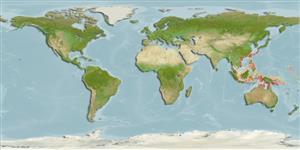>
Gobiiformes (Gobies) >
Gobiidae (Gobies) > Gobiinae
Etymology: Istigobius: Greek, istios = sail + Latin, gobius = gudgeon (Ref. 45335).
Eponymy: Dr Douglas Houghton Campbell (1859–1953) was a botanist and a Professor at Stanford University. [...] (Ref. 128868), visit book page.
More on authors: Jordan & Snyder.
Environment: milieu / climate zone / depth range / distribution range
экология
морской демерсальный; пределы глубины 3 - 14 m. Tropical; 30°N - 15°S
Northwest Pacific: southern Japan, Taiwan, and Hong Kong.
Length at first maturity / Size / Вес / Возраст
Maturity: Lm ?, range 2 - ? cm
Max length : 7.1 cm TL самец/пол неопределен; (Ref. 420); 7.8 cm TL (female)
колючие лучи спинного плавника (общее число) : 7; членистые (мягкие) лучи спинного плавника (общее число) : 10 - 11; колючие лучи анального плавника: 1; членистые (мягкие) лучи анального плавника: 9 - 10; позвонки: 26. Upper pectoral fin rays entire. Predorsal cycloid scales 10-13; ctenoid on trunk. Body dusky brown with red spots; 4 blue spots on operculum; black line running from eye along sensory pore path to pectoral base; 2 dusky blotches on pectoral base, the uppermost spreading onto fin rays; large inverted `U'-shaped blotch on the cheek. In male, appressed anal fin occasionally reaching caudal fin, appressed dorsal reaching or overlapping caudal fin. Appressed anal and dorsal fins of female ending 2-3 and 1-2 scales, respectively, of caudal fin.
Common in sandy bottoms of shallow waters. Also observed to live solitarily or in small schools near crevices or under stones. Occurs at 21.5 °C (Ref. 4959).
Genital papilla of male terminating to side of anal spine, of female terminating well before origin of anal fin and sometimes it is slightly pigmented.
Murdy, E.O. and D.F. Hoese, 1985. Revision of the gobiid fish genus Istigobius. Indo-Pac. Fish. (4):41 p. (Ref. 420)
Статус Красного Списка МСОП (Ref. 130435: Version 2024-1)
Угроза для людей
Harmless
Использование человеком
дополнительная информация
инструменты
Специальные отчеты
Скачать в формате XML
ресурсы в Интернет
Estimates based on models
Preferred temperature (Ref.
123201): 24.3 - 28.1, mean 27.4 °C (based on 299 cells).
Phylogenetic diversity index (Ref.
82804): PD
50 = 0.5010 [Uniqueness, from 0.5 = low to 2.0 = high].
Bayesian length-weight: a=0.01023 (0.00477 - 0.02194), b=3.01 (2.83 - 3.19), in cm total length, based on LWR estimates for this (Sub)family-body shape (Ref.
93245).
Trophic level (Ref.
69278): 3.3 ±0.3 se; based on size and trophs of closest relatives
устойчивость к внешним воздействиям (Ref.
120179): высокий, минимальное время удвоения популяции до 15 месяцев (Preliminary K or Fecundity.).
Fishing Vulnerability (Ref.
59153): Low vulnerability (10 of 100).
Nutrients (Ref.
124155): Calcium = 455 [217, 1,141] mg/100g; Iron = 1.73 [0.93, 3.44] mg/100g; Protein = 17.6 [15.8, 19.2] %; Omega3 = 0.235 [0.094, 0.480] g/100g; Selenium = 30.1 [14.5, 66.1] μg/100g; VitaminA = 39.3 [10.9, 126.7] μg/100g; Zinc = 2.31 [1.53, 3.52] mg/100g (wet weight);
